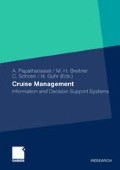Abstract
The fast growing cruise line industry anticipates huge uncertainties in its business environment. The cruise companies face uncertainty from four main sources: demand, competition, distribution channel, as well as the economic and political environment. The uncertainty brings risks as well as opportunities for the cruise industry, and a key issue is to understand the nature of the uncertainty and optimize profit by using appropriate management techniques. Depending on the prediction of expected customer preferences, different revenue management strategies should be implemented (Ji & Mazzarella, 2006). In this study, we developed simulation framework to compare 3 different revenue management methods with the simulated data. The first method is the First Come First Service (FCFS); the second method was the Dynamic Class Allocation (DCA). The last method, the Modified DCA, was derived by updating the underlying distributions of demand by current booking data with Bayesian approach. The aim is to find a universal powerful method which depends less on the revenue manager’s subject prediction of the demand by combining his belief and the real time booking data. The simulation result shows that when the demand estimated from historical data was not representing the future, by using the modified method, we can significantly improve revenue by updating demand information.
Access this chapter
Tax calculation will be finalised at checkout
Purchases are for personal use only
Preview
Unable to display preview. Download preview PDF.
References
Bellman, R. (1957), Applied Dynamic Programming. Princeton, N.J.: Princeton UniversityPress.
Cox, R.T. (1946), Probability, frequency and reasonable expectation, Amer. J. Phys. 14:1–13.
Cox, R.T. (1961), The algebra of probable inference, The Johns Hopkins Press, Baltimore, Md.
Cross, R. G. (1997), Revenue Management. Hard-core tactics for market domination. Broadway Books, New York, Pg. 51.
Forgacs G. (2010), Revenue Management. Maximizing Revenue in Hospitality Operations. The American Hotel and Lodging Educational Institute, Pg. 3.
Ji, L., Mazzarella J. (2006), ‘Application of modified nested and dynamic class allocation models for cruise line revenue management’, Journal of Revenue and Pricing Management, 6, 1, 19–32.
Savage LJ (1972), The foundations of statistics, revised edn. Dover Publications Inc., New York.
Shy, O. (2008), How to Price. A Guide to Pricing Techniques and Yield Management, Cambridge University Press, Pg. 228.
Editor information
Rights and permissions
Copyright information
© 2012 Gabler Verlag | Springer Fachmedien Wiesbaden GmbH
About this chapter
Cite this chapter
Ma, D., Sun, J. (2012). Revenue Management System for the Cruise Industry: A Simulation Study. In: Papathanassis, A., Breitner, M., Schoen, C., Guhr, N. (eds) Cruise Management. Gabler Verlag. https://doi.org/10.1007/978-3-8349-7159-3_11
Download citation
DOI: https://doi.org/10.1007/978-3-8349-7159-3_11
Publisher Name: Gabler Verlag
Print ISBN: 978-3-8349-3272-3
Online ISBN: 978-3-8349-7159-3
eBook Packages: Business and EconomicsBusiness and Management (R0)

